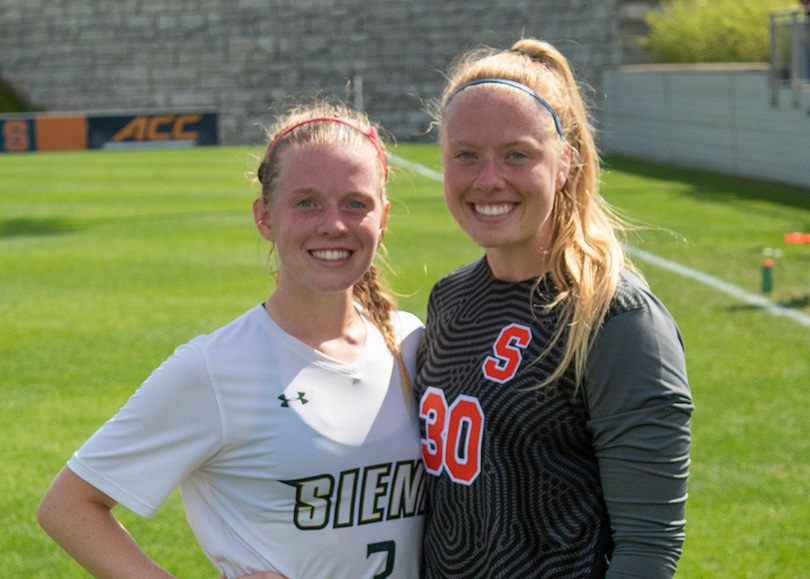Seeing double: The Vanderbosch twins rose to Division I soccer as a unit

Courtesy of SU Athletics
Shea and Kam Vanderbosch’s twin connection and competitive nature helps them excel in Division I soccer.
Get the latest Syracuse news delivered right to your inbox. Subscribe to our sports newsletter here.
Everyone knew Kam Vanderbosch wanted to score against Shea Vanderbosch.
When Siena won a free kick in its regular season match against Syracuse, the Saints elected to have Kam take it. She struck one aimed for the bottom right corner. Shea raced from one post to the other, catching the attempt. She fell to the ground and was able to clutch possession to her chest.
“I was just like, ‘Ok, if anybody could actually score on Shea it would be Kam because she knows how to score on her,’” said their mother Pam Vanderbosch. “But then Shea knows exactly where Kam is going to go.”
For most of their lives, the 60-second difference at birth was the only thing separating Shea and Kam. They now play two hours apart, with Shea playing goalie at Syracuse and Kam playing center back for Siena. Throughout their childhood, the Vanderbosch twins did everything together – especially soccer.
Once Shea and Kam began playing in a youth league, the pair became obsessed. They moved from youth to travel soccer, motivated to get even better. When they returned home from their hour-and-a-half-long practices, they went straight to the backyard. Kam took shots at Shea for another hour.
“I just wanted to score on her,” Kam said. “Even if I don’t, I love the competitive nature that we have.”

Sierra Zaccagnino | Digital Design Editor
Shea was born to be a goalkeeper. She’s a natural when it comes to organizing a defense or barking warnings at the midfield. In elementary school, she once got in trouble for being “too bossy” to her classmates.
In eighth grade, Kam switched from forward to center back, placing her closer to Shea on the field. Though Shea had always been vocal, she took it to another gear once Kam started playing center back. Pam remembered Shea screamed louder at Kam than any other center back she’s played with.
“Since I’m a goaltender and she’s a center back, she’s literally right in front of me,” Shea said. “I feel like we were very close off of the field, so it made us have a better connection on the field.”
The sisters played on the same team together until they turned 14 and Shea was called up to play with an older group.
But Shea didn’t want to play without her. Kam would go to Shea’s games to support her, even if it required a road trip. While Shea got in-game reps against higher-level competition, Kam soaked in the game.
The twins dominated when they played together. The two regularly matched up against the second and third teams of Western New York Flash — a nearby youth soccer developmental program. Rob Ferguson, the current head coach of Cornell women’s soccer and the former director of the Flash, said that the Flash’s second team was possibly the best team in the area.
Ferguson occasionally coached the second team. After watching Shea play, Ferguson knew she was the best goalkeeper in western New York and possibly the best in the Northeast. He also recognized Kam as a strong and reliable center back.
“We don’t recruit them both because they’re twins,” Ferguson said. “They both got to be good enough … I wouldn’t have been recruiting anyone to that team who I didn’t think was a high-level Division-I player.”

Arlo Stone | Digital Design Director
The Flash’s first team played in the Elite Clubs National League (ECNL) – a premier league requiring the team to travel across the country for games and tournaments.
Despite Ferguson recruiting both, it took over a year for the Vanderbosches to commit to the Flash. Once they joined, Ferguson only spent half a season working with them before becoming Cornell’s assistant head coach. Playing alongside 12 players committed to playing Division-I soccer, the twins improved dramatically.
“We really liked the team, atmosphere and how hard it pushed us,” Vanderbosch said. “It’s a training environment where there’s always someone behind you and always pushing you to be better, so you’ve got to step up and perform.”
Despite playing for different schools, they train together over the summer and remain heavily invested in each other’s careers.
Shea and Kam do whatever they can to watch each other play. During games, Vanderbosch regularly sends Kam a text complimenting a slide tackle while Kam will praise one of Vanderbosch’s saves. The two also FaceTime each other almost every night, and after games, they go over each other’s performances and provide honest critiques.
“They’re very competitive but they are the absolute best of friends and each other’s biggest cheerleaders,” Pam said.





